
Prosta-Blue Zone
Prosta-Blue Zone
Prostatitis, Prostate Enlargement and Cancer: The Role of Chronic Infection
Prosta-Blue Zone
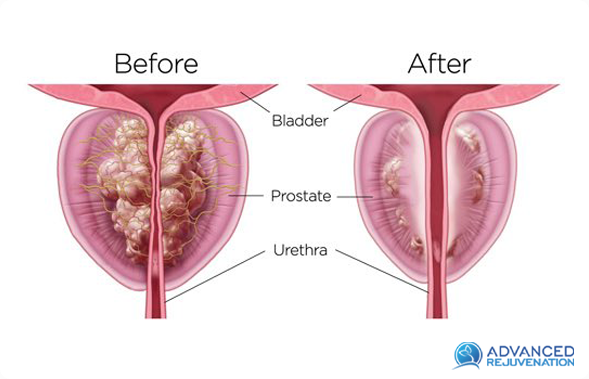
The prostate gland is a small, walnut-sized organ that sits below the bladder in men. It produces a fluid that helps transport sperm during ejaculation. Prostate enlargement, also known as benign prostatic hyperplasia (BPH), is a common condition that affects many men as they age. BPH can cause symptoms such as urinary frequency, urgency, and difficulty urinating. Prostate cancer is another condition that affects men. It is the second most common cancer in men after skin cancer. Prostate cancer can be aggressive and spread to other parts of the body.
There is evidence that chronic infection within the prostate gland may play a role in both BPH and prostate cancer.[1] The prostate gland has poor circulation, which makes it susceptible to infection. One study found that men with BPH were more likely to have bacteria in their prostate fluid than men without BPH.[2]
Prostatitis vs. BPH (Enlarged Prostate): What’s the Difference?
Men with prostate cancer are more likely to have a history of prostatitis, which is inflammation of the prostate gland.[3] The cause of the inflammation is infection that is thought to come from the bladder, which communicates from the urethra up through the penis. BPH, meanwhile, is considered a condition for which the medical field has no root cause associated with its development. Most men over the age of 50 have prostate enlargement due to proliferation of the cells that comprise the prostate gland. Many men have BPH even though they do not have any symptoms.
There is only one type of BPH: benign, meaning noncancerous, or not malignant. However, there is evidence that chronic infection within the prostate gland may play a role in BPH, prostatitis, and even prostate cancer.

In a study that looked at infection as the root cause of BPH, the research found the presence of microbiome dysbiosis in BPH, “and suggests that Pseudomonas, as the dominant microflora, may promote the progression of BPH through LPS activation of NF-κB signaling.”[4]
Several studies have demonstrated the presence of bacterial and viral strains in BPH specimens. These strains may lead to the production of proinflammatory cytokines and chemokines by BPH stromal cells, which may lead to prostatic growth.[5] Keep in mind, none of the studies I looked at investigated fungal causes, and in my clinic’s semen testing through Micro-Gen’s next-generation sequencing (NGS), we are detecting the presence of Pseudomonas along with a wide variety of microbes.
Infections have even shown a change in the receptors within the immune system of the prostate gland, making the cells in the prostate more sensitive to proliferation from androgenic influence such as dihydrotestosterone (DHT). Traditionally, age and androgens have been considered the primary culprit of prostate enlargement, but in more recent years, the potentially important role of chronic inflammation in BPH has emerged.[6] One needs only to consider the cause of the inflammation and the true root cause of prostate enlargement becomes obvious.
Chronic Prostate Infection and Infertility
Mean sperm counts are declining at an accelerated rate, and infertility is becoming a public health concern. It is now understood that human semen, previously considered to be sterile, harbors its own specific microbiome. Activated immune cells and leukocytes, as well as reactive oxygen species resulting from infection, can evoke an immune response which may lead to sperm damage.[7] One study showed significant differences in the seminal microbiome between men with evidence of infection (tested with NGS) as it relates to infertility and men with low sperm counts. These results suggest infection may play a causal role in male infertility.[8]
Normal Growth of Prostate in Men
The study titled “Prostate Volume Changes over Time: Results from the Baltimore Longitudinal Study of Aging” looked at 540 men at a median age of 58 and showed prostate volume increased at rate of 2.5% annually. In addition, 61.9% of men tested in this study showed prostate growth.[9] From these parameters, prostate width and height had a relatively stable rate of increase and changed little among men aged 40–49 and 50–59 years. The length of the prostate increases faster than the height and width, especially after age 60. Before the age of 60, the prostate grows slowly, while after age 60, the length becomes the main growth line. Intravesical prostatic protrusion has been implicated in the increase in prostate length. Research has found that the degree of intravesical prostatic protrusion was positively correlated with age (r=0.210; P<0.01) and an increase in intravesical prostatic protrusion contributed to the prostate length increase, causing bladder outlet obstruction in BPH patients.[10] To measure the size and shape of a prostate, it is best to use either MRI or, as we do in our clinic, ultrasound.
Testing Semen for Chronic Infection within the Prostate
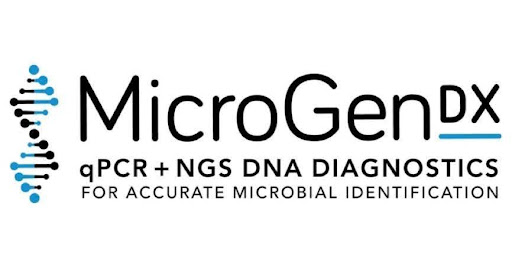
In our clinic, we do semen testing to determine the type of microbes involved, and often there are several. The test is easy and can be done at home. Results include a list of what was found, and the microbes are tested to determine their susceptibility to various antibiotics. Sometimes there are fungi, and although viruses are not tested, I would assume they would be found as well.
It’s basically a soup of infection in many cases. It’s not the usual standard of care to do this test in the USA, which I find to be a major shortcoming of the medical establishment.
These infections settle within the prostate because there is poor circulation in the gland such that the immune system cannot get to the microbes. It’s stagnant, like a swamp. Microbes love to grow in stagnant and toxic places where they can hide from your immune system. MicroGen, an Orlando-based diagnostics lab, uses next-generation sequencing (NGS), which is superior and more sensitive than standard testing available through most labs, such as Labcorp.[11] The use of this higher level of testing has demonstrated that there are far more infections present in both urine and semen, causing many lower urinary tract symptoms. Below are examples of semen tests our clinic performed in which a variety of microbes were detected.
Aside from NGS semen testing, the PSA blood test is the gold standard for prostate cancer screening. PSA stands for prostate specific antigen: a protein produced by the prostate, elevated levels of which may indicate the presence of cancer. As mentioned earlier, imaging of the prostate to measure the size and shape can also be important, and MRI or ultrasound would be best to do this.
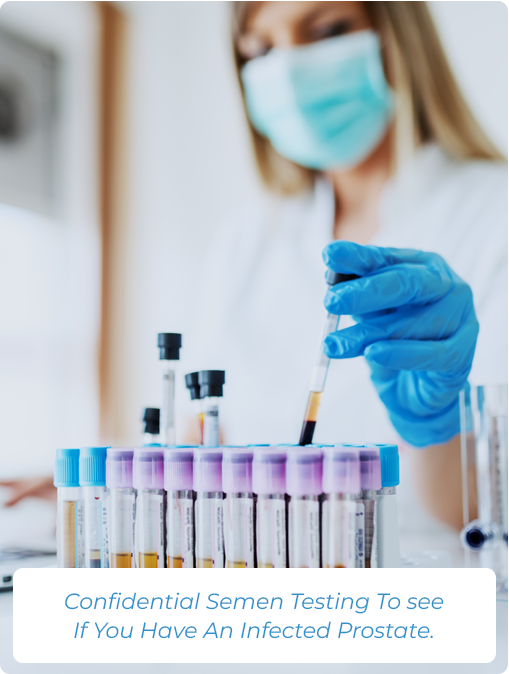
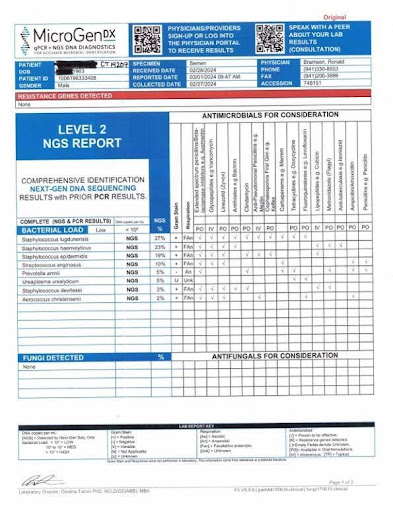
Innovations in Treating Prostate Enlargement
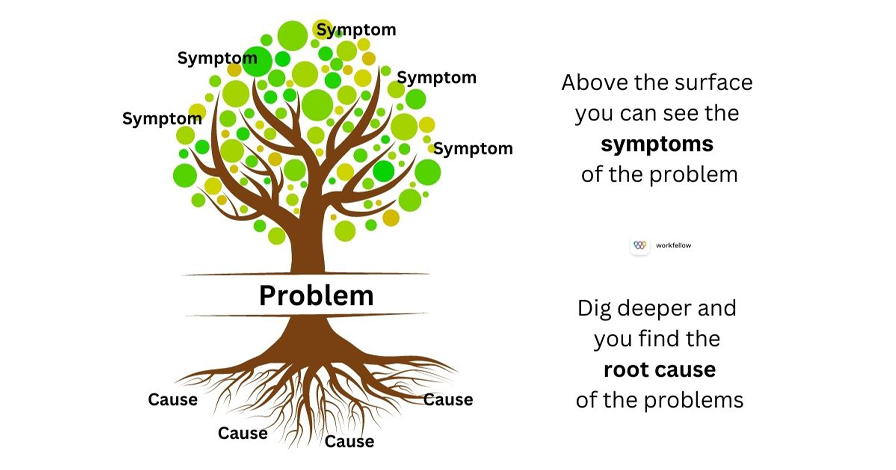
While most therapies for prostate enlargement treat the symptoms, at Advanced Rejuvenation, we target the underlying cause using an innovative therapy called ProstaBlueZone. ProstaBlueZone is a prostate therapy composed of methylene blue, targeted antibiotics, and ozone to treat the underlying cause of prostate enlargement.
We begin with the NGS semen test that shows which microbes are infecting your prostate and which antibiotics work against them. We pair this with methylene blue, a compound that has significant antimicrobial effects yet leaves the body unharmed.
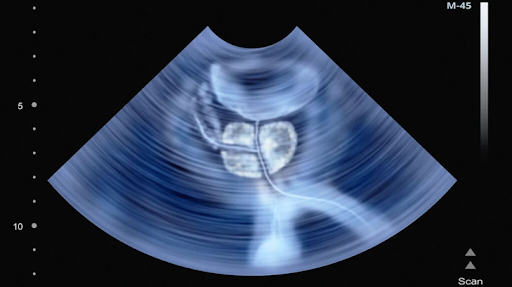
Your Prostate Has Poor Circulation and Is Like a
Swamp, Accumulating Unresolved Infections.
We combine all of this with ozone therapy, which is a treatment that uses ozone gas to repair tissue and/or kill bacteria and other microorganisms. It has been used to treat a variety of conditions, including BPH and prostate cancer. One study found that ozone therapy was effective in reducing the size of the prostate in men with BPH.[12] Another study found that ozone therapy could kill prostate cancer cells in vitro.[13]
TAKE THE NEXT STEP
Order your AT
HOME TEST Kit
Simply fill out the form below to start the ordering process for your at home test kit. This is a 20 Minute Prostate Consultation with one of our medical staff team member
to go over the process and answer any questions you may have.
To explore the next steps in how the medical team at Advanced Rejuvenation can assist you in optimizing your prostate health, please complete the form below. Our team will schedule a call to discuss your needs and answer any questions you may have about the treatments we provide.
How Methylene Blue And Red Light Therapy Might Help With Prostate Disease.

Prostate disease is a common condition in men, and it can range from mild to severe. The two most common types of prostate disease are benign prostatic hyperplasia (BPH) and prostate cancer.
BPH is a non-cancerous enlargement of the prostate gland. It can cause symptoms such as urinary frequency, urgency, and difficulty urinating. RLT has been shown to be effective in reducing the size of the prostate in men with BPH.
Prostate cancer is a more serious condition, but it is often treatable. The standard treatment for prostate cancer is surgery, radiation therapy, or hormone therapy. However, these treatments can have side effects, and they may not be effective for all patients.
MB and RLT therapy may be a potential alternative treatment for prostate cancer. In animal studies, MB and RLT therapy have been shown to shrink tumors and kill cancer cells. More research is needed to determine whether MB and RLT therapy is safe and effective in humans with prostate cancer.
Using MB in a suppository for this indication makes good sense to get the medicine to concentrate where it is needed most. Getting red light to the prostate is possible using the MitoWand light made by MitoZen.Club. They also make a 60mg methylene blue suppository called Lumetol Blue.
Putting it all together.
Prosta BlueZone is a revolutionary treatment protocol utilizing all of these modalities. We combine various anti-microbial agents such as methylene blue with light therapy, and targeted antibiotics along with ozone injections, all of which is done in the clinic under ultrasound guidance. On occasion, we also will use shock wave therapy when necessary and an optional ED "P Shot". The treatment is targeted based on the results of semen testing performed before treatment. This is done over 3 outpatient visits in our Sarasota clinic. After the treatment, a follow-up semen test is performed to determine if the infection has been cleared.
Get Started Below
Copyright © 2024 | Advanced Rejuvenation | All rights reserved.
Address: 1014 North East AvenueSarasota, Florida 34237
Phone: (941) 330-8553
Prostate Enlargement and Cancer: The Role of Chronic Infection
https://www.ncbi.nlm.nih.gov/pmc/articles/PMC4219279/
Ozone Therapy for Prostate Enlargement and Cancer
https://www.ncbi.nlm.nih.gov/pmc/articles/PMC3552388/
https://www.ncbi.nlm.nih.gov/pmc/articles/PMC6421061/
Shock Wave Therapy for Benign Prostatic Hyperplasia:
https://www.ncbi.nlm.nih.gov/pmc/articles/PMC3822685/
Shock Wave Therapy for Erectile Dysfunction:
https://www.ncbi.nlm.nih.gov/pmc/articles/PMC5398756/
Shock Wave Therapy for Chronic Prostatitis/Chronic Pelvic Pain Syndrome:
Methylene Blue and Red Light Therapy for Cancer:
https://www.ncbi.nlm.nih.gov/pmc/articles/PMC6421061/
Red Light Therapy for Prostate Cancer:
https://www.ncbi.nlm.nih.gov/pmc/articles/PMC6740385/
Methylene Blue as a Photosensitizer for Cancer Treatment:
https://www.ncbi.nlm.nih.gov/pmc/articles/PMC5353937/
Red Light Therapy: Benefits, Side Effects & Uses:
https://my.clevelandclinic.org/health/articles/22114-red-light-therapy
Is Red Light Therapy Safe – Does It Cause Skin Cancer?: